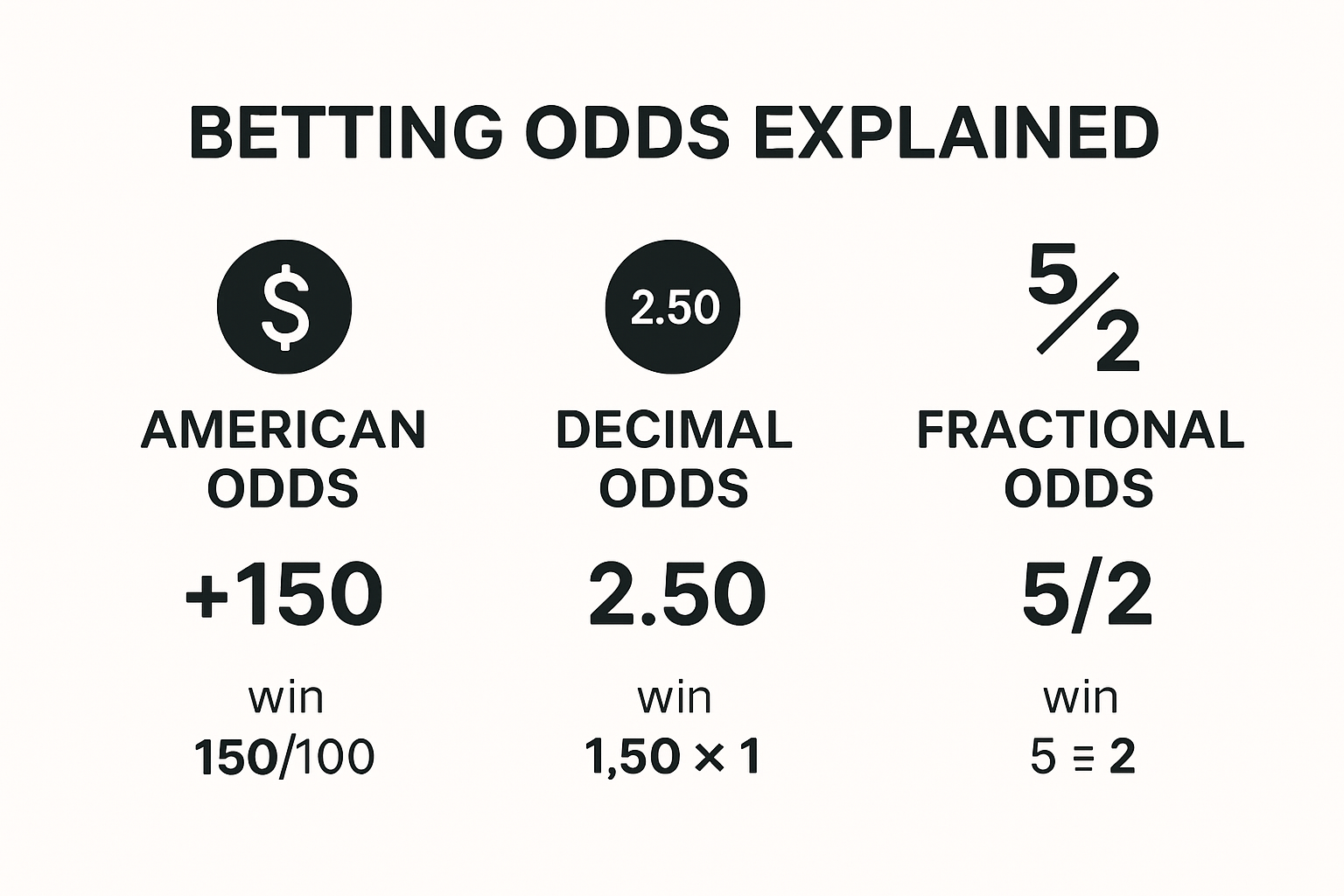
Betting odds control how much you stand to win and how risky your wager really is. Most people only see the numbers, but odds are far more than price tags. Here is the real kicker. Choosing the wrong odds format can leave you with up to 30 percent less in payouts, and that mistake is surprisingly common among new and experienced bettors alike.
Table of Contents
- Understanding The Basics Of Betting Odds
- Types Of Odds And Their Impact On Payout
- How To Calculate Payouts From Odds
- Tips To Maximize Payouts Using Odds
Quick Summary
| Takeaway | Explanation |
|---|---|
| Understanding Odds Formats | Familiarize yourself with American, decimal, and fractional odds to effectively assess risks and payouts across different betting systems. |
| Calculating Implied Probability | Use the appropriate formulas to convert odds into implied probabilities, enabling you to evaluate the true value of your bets and distinguish between favorable and unfavorable wagers. |
| Strategic Bankroll Management | Stick to a disciplined betting approach by limiting wagers to 1-3% of your total bankroll, which helps protect against significant losses while supporting long-term sustainability in betting. |
| Value Betting Techniques | Look for odds that misrepresent the actual probability of an outcome to maximize potential payouts, emphasizing a thorough comparison of odds across multiple bookmakers. |
| Psychological Discipline | Maintain emotional control by establishing win/loss limits and avoiding impulsive decisions to enhance your betting effectiveness and promote strategic thinking. |
Understanding the Basics of Betting Odds
Betting odds represent the probability of an event occurring and determine potential winnings for bettors. These numerical representations translate complex statistical calculations into straightforward formats that help gamblers assess potential risks and rewards.
Decoding Odds Formats
Understanding betting odds requires familiarity with three primary formats: American, decimal, and fractional. Explore our comprehensive betting guide to master these essential systems.
American Odds: Expressed with positive and negative numbers, these odds indicate potential profit relative to a $100 stake. Positive numbers (like +200) show how much you’d win on a $100 bet, while negative numbers (like -150) reveal how much you must wager to win $100.
For instance, a +200 bet means a $100 wager could return $300 total ($200 profit plus the original $100 stake). Conversely, a -150 bet requires wagering $150 to potentially win $100, demonstrating the inverse relationship between risk and potential return.
Decimal Odds: Popular in Europe and Australia, decimal odds represent the total payout per unit bet. A 2.50 decimal odd means for every $1 wagered, you’ll receive $2.50 if successful – including your original stake.
Fractional Odds: Common in the United Kingdom, these odds show potential profit relative to the stake. A 5/1 fractional odd means winning $5 for every $1 bet, plus the original stake returned.

Probability and Implied Odds
Odds are more than numerical representations; they reflect statistical probabilities. According to research from gambling probability experts, the house edge increases as odds lengthen, meaning longer odds often carry higher financial risks for bettors.
Implied probability helps bettors understand the likelihood of an outcome. By converting odds to percentages, you can assess whether a bet offers genuine value. For example, American odds of +200 translate to roughly a 33% implied probability of winning.
The calculation involves this formula: 100 / (odds + 100) for positive odds, and absolute(negative odds) / (absolute(negative odds) + 100) for negative odds. This mathematical approach transforms raw numbers into actionable insights.
Strategic Considerations
Effective betting requires understanding how odds reflect potential outcomes. Advanced betting strategies emphasize analyzing odds beyond face value.
In “over-under” betting scenarios, statistical research suggests wagering on the “over” when the set number is less than the median total points distribution maximizes expected profit.
Bettors should remember that odds represent probabilistic predictions, not guarantees. They fluctuate based on team performance, injuries, historical data, and real-time developments. Successful gambling requires continuous learning, disciplined bankroll management, and a nuanced understanding of how odds translate mathematical probabilities into potential winnings.
Types of Odds and Their Impact on Payout
Understanding the nuanced relationship between different types of odds and their corresponding payouts is crucial for strategic betting. Each odds format carries unique implications for potential winnings and risk assessment.
Moneyline (American) Odds: Risk and Reward Dynamics
Moneyline odds represent the most direct representation of potential profit in American sports betting. These odds communicate not just probability, but the financial risk-reward calculation for each wager. Check out our advanced odds interpretation guide to deepen your understanding.
Positive moneyline odds (e.g., +250) indicate an underdog scenario where a $100 bet could return $250 in profit. Negative moneyline odds (e.g., -150) suggest a favored outcome, requiring a $150 bet to win $100. According to research from gambling probability experts, these odds directly reflect the bookmaker’s assessment of potential outcomes and inherent risk.
Decimal and Fractional Odds: Global Betting Perspectives
Decimal odds, prevalent in Europe and Australia, provide a straightforward total payout calculation. A 3.00 decimal odd means a $1 bet returns $3 total (including the original stake). This format simplifies understanding potential returns without complex mathematical conversions.
Fractional odds, common in the United Kingdom, express potential profit relative to the stake. A 5/1 fractional odd means winning $5 for every $1 wagered, plus returning the original stake. These odds highlight the potential profit margin more explicitly than decimal formats.
To help compare the main types of betting odds, the table below summarizes their formats, calculation methods, and regions where they are most common.
| Odds Format | How It’s Written | Calculation Method | Main Regions |
|---|---|---|---|
| American | +200 or -150 | Profit on $100 (positive) or amount to risk (negative) | USA |
| Decimal | 2.50 or 3.00 | Stake × Decimal Odds = Total Return | Europe, Australia |
| Fractional | 5/1 or 3/2 | Stake × Fraction = Profit | UK |
Calculating Implied Probability and House Edge
Beyond simple payout calculations, understanding implied probability is essential for informed betting strategies. Implied probability transforms odds into percentage chances of an outcome occurring. For instance, American odds of +200 translate to approximately a 33% probability of winning.
The house edge plays a critical role in odds calculation. Comprehensive statistical analysis reveals that as odds lengthen, the bookmaker’s potential profit margin increases. This means longer odds often carry higher financial risks for bettors.
Professional bettors recognize that odds are dynamic. They fluctuate based on numerous factors including team performance, player injuries, historical data, and real-time developments. Successful betting requires continuous learning, understanding mathematical probabilities, and maintaining disciplined bankroll management.
Navigating different odds formats demands practice and strategic thinking. By comprehending how each format represents potential payouts and probabilities, bettors can make more informed decisions and develop more sophisticated betting approaches.
How to Calculate Payouts from Odds
Calculating payouts from betting odds requires a strategic approach that varies depending on the odds format. Understanding these calculations empowers bettors to make informed decisions and accurately predict potential winnings.
American Odds Payout Calculations
American odds represent potential profit relative to a $100 stake, with distinct calculation methods for positive and negative numbers. Learn more about advanced betting strategies to refine your approach.
For positive odds (e.g., +250), the calculation follows this formula: Potential Profit = (Stake × Odds) / 100. So a $50 bet at +250 would calculate as: ($50 × 250) / 100 = $125 profit, resulting in a total return of $175 (original stake + profit).
Negative odds (e.g., -150) require a different approach. The formula becomes: Potential Profit = Stake / (Odds / 100). A $100 bet at -150 would result in a $66.67 profit, with a total return of $166.67.
Decimal and Fractional Odds Payout Methods
Decimal odds offer the most straightforward payout calculation. According to research from betting probability experts, the total payout is calculated by multiplying the stake by the decimal odds. A $50 bet at 3.50 decimal odds would return $175 total ($50 × 3.50), which includes the original stake.
Fractional odds, popular in the United Kingdom, show potential profit relative to the stake. A 5/1 fractional odd means winning $5 for every $1 wagered. A $20 bet at 5/1 would generate $100 in profit, with a total return of $120 (original $20 stake + $100 profit).

The table below summarizes example payouts for each odds format using a sample stake, as described in this section. This helps illustrate the differences in returns depending on the betting odds used.
| Odds Format | Example Odds | Stake | Example Profit | Total Return |
|---|---|---|---|---|
| American (+250) | +250 | $50 | $125 | $175 |
| American (-150) | -150 | $100 | $66.67 | $166.67 |
| Decimal | 3.50 | $50 | $125 | $175 |
| Fractional | 5/1 | $20 | $100 | $120 |
Advanced Payout Considerations
Beyond basic calculations, comprehensive statistical analysis reveals important nuances in payout mathematics. Implied probability plays a crucial role in understanding potential returns. This calculation converts odds into percentage chances of an outcome, helping bettors assess true value.
Implied probability for American odds can be calculated using these formulas:
- Positive odds: 100 / (odds + 100)
- Negative odds: absolute(negative odds) / (absolute(negative odds) + 100)
Professional bettors understand that payout calculations are dynamic. Odds fluctuate based on multiple factors including team performance, player injuries, historical data, and real-time developments. Successful betting requires continuous learning, mathematical precision, and disciplined bankroll management.
Mastering payout calculations transforms betting from pure chance to a more strategic endeavor. By understanding how different odds formats translate into potential winnings, bettors can make more informed decisions and develop sophisticated betting approaches that maximize potential returns while managing financial risk.
Tips to Maximize Payouts Using Odds
Maximizing payouts requires strategic thinking, deep understanding of odds, and disciplined betting approaches. Successful bettors recognize that intelligent betting goes beyond simple wager placement.
Understanding Value and Risk Management
Identifying betting value is crucial for maximizing potential payouts. Learn more about strategic sports betting to enhance your approach. Value betting involves finding odds that underestimate the actual probability of an outcome.
According to research on gambling probabilities, the house edge increases with more complex bets. Professional bettors mitigate this by carefully selecting wagers with the most favorable risk-reward ratios. This means comparing odds across multiple bookmakers and identifying discrepancies that create potential profit opportunities.
Risk management remains paramount. A disciplined approach suggests never wagering more than 1-3% of your total bankroll on a single bet. This strategy prevents catastrophic losses while maintaining long-term betting sustainability.
Advanced Odds Optimization Techniques
Statistical analysis reveals complex betting strategies that can optimize potential payouts. Comprehensive research indicates that bettors who understand implied probability can make more informed decisions.
Key optimization techniques include:
- Comparative Odds Analysis: Compare odds across multiple platforms to identify the most favorable lines.
- Implied Probability Calculation: Convert odds to percentage chances, helping assess true bet value.
- Hedging Strategies: Place complementary bets to minimize potential losses while maintaining profit potential.
Implied probability calculations help bettors understand the true likelihood of an outcome. For American odds, use these formulas:
- Positive odds: 100 / (odds + 100)
- Negative odds: absolute(negative odds) / (absolute(negative odds) + 100)
Psychological and Strategic Considerations
Betting success extends beyond mathematical calculations. Research on wagering incentives demonstrates that emotional decision-making can significantly impact betting outcomes. Professional bettors maintain strict emotional discipline, avoiding impulsive wagers driven by excitement or recent losses.
Key psychological strategies include:
- Maintaining a detailed betting log to track performance
- Setting strict win and loss limits
- Avoiding chasing losses
- Continuously educating yourself about betting strategies
The most successful bettors treat gambling as a calculated investment, not a random chance activity. They understand that long-term success requires consistent strategy, mathematical precision, and emotional control.
Remember, maximizing payouts is not about winning every bet, but about making statistically sound decisions that provide positive expected value over time. Continuous learning, disciplined bankroll management, and a strategic approach are the cornerstones of successful betting.
Frequently Asked Questions
What are the different types of betting odds?
Betting odds can be expressed in three primary formats: American (moneyline), decimal, and fractional. American odds indicate potential profit or required stake, while decimal odds show total payout per unit bet, and fractional odds depict profit relative to the stake.
How do I calculate my payouts based on betting odds?
Payout calculations vary by odds format. For American odds, the formula for positive odds is (stake × odds) / 100. For negative odds, use stake / (odds / 100). For decimal odds, simply multiply the stake by the decimal odds. Fractional odds require multiplying the stake by the fraction to determine profit.
What is implied probability in betting?
Implied probability translates betting odds into percentage chances of an outcome occurring. This helps bettors evaluate whether a wager offers true value. The calculation depends on the odds format and can indicate the likelihood of winning a bet.
How can I maximize my betting payouts?
To maximize payouts, look for value bets that misrepresent the actual probability of an outcome, manage your bankroll by limiting wagers to 1-3% of your total funds, and continuously compare odds across multiple bookmakers to find the best lines.
Transform Your Odds Knowledge Into Real Betting Success
Wondering how turning mathematical odds into winning strategy actually works in practice? You have just learned how choosing the right format and understanding implied probability can seriously impact your payouts. But bridging this know-how with true results takes more than theory. Betco AG gives you the platform, the odds, and the live markets you need to test and refine your strategy right now.

Ready to move from learning to real winning? Dive deeper with our Sports Betting Guides and Resources where you will find expert tips, practical tools, and further insights on maximizing payout. Sign up or log in at Betco AG to put your knowledge to work. Don’t wait—every smart bet you make today gets you closer to the returns and excitement you want.
Recommended
- Best Sports for Betting: Football, Basketball, and Beyond – Betco
- How to Bet on Sports: A Beginner’s Guide | Betco Sports
- How Bonuses & Promotions Work on Betting Platforms | Betco
- Betting Strategies for NBA, NFL & Soccer Seasons | Betco
- How to Interpret Odds and Probabilities in Sports Betting | Betco
- Tips and Tricks to Win at Online Slots | Betco

Great Information , thanks for the insight. I love this Betco Sportsbook and Casino, keep’em comming.